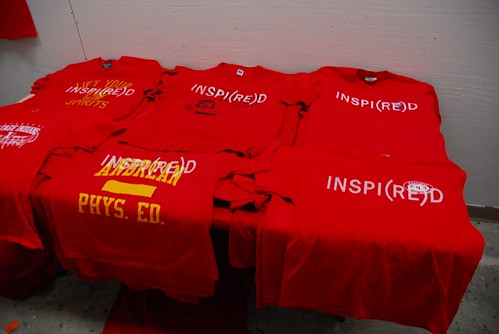Rob Kalin, CEO of Etsy, which was a key feature of the Handmade 2.0 story I did for the NYT Mag in December, writes here that the company has taken a $27 million investment from two of its current backers. He says Etsy is almost breaking even; explains why it needs the investment; and mentions the long-range plan of going public.
But if you read the Handmade 2.0 story, you might be particularly interested in the accompanying video. You may recall that the article recounted Kalin explaining Etsy to me by reading me a children’s book. Well, now you can have the same experience! Or a virtual equivalent. Click through to hear the story of Swimmy.
Update 1/31: VentureBeat links to a quite good story from Tech Confidential on Etsy’s financing. I didn’t get into any of this stuff in the Handmade 2.0 story, but everything here pretty much lines up with what Kalin said to me about that side of things. Moreover, there are a number of nice details that were news to me. (Example: “He got his first Web design job without admitting he had no experience. (The Web site he created for Manhattan pub Acme Bar and Grill is still up today.)”) So if the biz side of Etsy is of interest to you — and actually, if the general subject of VCs and company funding interests you — check it out.
Posted Under:
DIYism by Rob Walker on January 30, 2008
Comments Off on Etsy founder announces investment, shares story of Swimmy
 Marketplace had an interview yesterday with Rachel Louise Snyder, whose book Fugitive Denim: A Moving Story of People and Pants in the Borderless World of Global Trade sounds interesting. Maybe your jeans say “Made in Country X,” but that’s not the whole story, she says:
Marketplace had an interview yesterday with Rachel Louise Snyder, whose book Fugitive Denim: A Moving Story of People and Pants in the Borderless World of Global Trade sounds interesting. Maybe your jeans say “Made in Country X,” but that’s not the whole story, she says:
You’ll have the cotton grown in a place like Uzbekistan or Azerbaijan — and in my book, it’s Azerbaijan — and maybe Turkey and then that’s woven, all the cotton from those countries is woven for consistency into one large roll of fabric and then its dyed in a different country like Italy and then sent maybe to India, where it might be cut, and then sent somewhere else. But you might have six or eight different countries involved in that process because of the way trade rules are set up.
And also:
We’ve now come up with these standards for food where it has to say where our food is processed and where it’s grown, but we don’t have those same standards for clothes.
Reminds me a bit of Travels of A T-Shirt in the Global Economy, a book I thought was pretty good, although I believe this one is more of a journalistic account, while Pietra Rivoli’s was a little more economics-focused. Anyway, I’m generally a fan of any account that gets beyond the oversimplified versions of ethics and consumption that tend to dominate. Check out the interview (transcript or audio) and see what you think.
Apparently so. A Washington Post blog quotes Bill Richardson discussing an incident during one of the Dem debates:
I had just been asked a question — I don’t remember which one — and Obama was sitting right next to me. Then the moderator went across the room, I think to Chris Dodd, so I thought I was home free for a while. I wasn’t going to listen to the next question. I was about to say something to Obama when the moderator turned to me and said, ‘So, Gov. Richardson, what do you think of that?’ But I wasn’t paying any attention! I was about to say, ‘Could you repeat the question? I wasn’t listening.’ But I wasn’t about to say I wasn’t listening. I looked at Obama. I was just horrified. And Obama whispered, ‘Katrina. Katrina.’ The question was on Katrina! So I said, ‘On Katrina, my policy . . .’ Obama could have just thrown me under the bus. So I said, ‘Obama, that was good of you to do that.’
First, “I wasn’t going to listen to the next question” might be the most honest politician statement of the entire campaign.
Second, I love that these people really just need a one-word cue (“Katrina!”) before they can launch into whatever their spiel might be.
Via TNR’s The Plank.
As it slips further down the page, I just want to plug again the recent guest column by Jean Railla, “What Would Jesus Sell?” The comments have gotten pretty interesting, and you might want to check them out, and possibly even weigh in yourself.
My favorite line in the comments so far:
What I think craft as a movement and Rev Billy both espouse is the idea that things should be hard to get. You shouldn’t have that many of them, and the ones that you do have you should cherish.

The widely discussed Product (Red) campaign has come up a couple of times here on Murketing. As you probably know, it involves various companies such as The Gap and Apple and American Express selling special red products: If you buy one, some portion of the proceeds go to fight AIDS in Africa. It’s fair to say that the response to this has been mixed.
One of the most interesting responses I’ve seen so far is an initiative called (RE). As its creators have explained, their view is that the (Red) campaign “implies that corporations, branding and consumption are a necessary and healthy part of involvement in a cause. ” The point of (RE) is to offer non-corporate alternatives for engagement in causes — and to provoke some deeper thinking about conspicuous consumption, engagement, and solving the world’s problems. (The while the name “(RE)” riffs off “(RED),” it’s also echoed by manifestations of the project that explicitly involve re-use.)
Through February 15, (RE) is part of an exhibition called Other Options, at (106) S. Division gallery in Grand Rapids, Michigan, a show originated by InCubate in Chicago. On February 15, the creators of (RE) will auction red items, any red item at all, donated by anyone who wants to donate. Proceeds will go to charity. This is an example of the sort of thing that falls under the (RE) project.
I had a few Qs, and (RE)’s creators, Ryan Thompson and Phil Orr graciously provided some As. Here goes:
I’m curious — having read your F.A.Q. — to what extent (RE) is a response not just to (Red) specifically, but to “cause marketing” in general. (It’s become quite popular, as you know, for products and brands to “give a portion of proceeds” or “raise awareness,” etc. — from the Livestrong bracelet to … well all kinds of things).
You’re exactly right. When the (PRODUCT) RED campaign started back in October of ’06 we saw the opportunity for a timely response to (PRODUCT) RED specifically, but as we continued to expand the project we became aware of its ability to speak to much larger issues — concerns within cause marketing as well as consumption, waste, labor, etc. These aren’t easy issues to engage as a business or a consumer. That shouldn’t mean that we give up on trying, but instead that we look carefully at what supporting a cause in a particular manner does for all parties involved.
There are three (RE) manifestations, or initiatives — were they all devised at once, or did the project start with one idea and evolve to include the others? Please continue…
 EXTRA HELPING:
EXTRA HELPING:
What happens when a philanthropic project becomes so popular it has trouble keeping up with demand?
This week Consumed looks at Kiva.org, which connects developing world entrepreneurs with people in the First World willing to make interest-free microloans. Maybe you’ve heard of Kiva: Its innovative model has been praised by everyone from Bill Clinton to Oprah Winfrey.
In fact, it’s partly because of all the attention that Kiva has had to cap loans at $25, to let more loaners participate. As a spokeswoman says: “We don’t want people coming to the Web site who want to make a loan and there’s no one to loan to.”
Read Consumed in the January 27, 2008, issue of The New York Times Magazine, or here.
Posted Under:
Consumed by Rob Walker on January 26, 2008
Comments Off on In The New York Times Mazine: Kiva.org
Jack Shafer’s fine piece in Slate — In Praise of Horse-Race Coverage — gives me the inspiration, or maybe the intellectual cover, to admit something. Everybody knows that campaign coverage is ridiculous: Too little focus on substance and policy, too much emphasis on image, personality, and “the horserace.” Even after reading Shafer’s piece, I would not really disagree. But even so, the fact of the matter is: I love the horserace.
I don’t mean to suggest that I think it’s all that useful in making a decision about who to vote for. But as Shafer says: “Even if the press corps had abandoned substance, no voter is more than a mouse click away from detailed policy papers and unfiltered campaign speeches by the candidates. If you’re not an informed political consumer this year, you have nobody to blame but yourself.”
What I love about the horserace is the story, or the stories. Not the supposed meta-story that various observers are always trying to extract from the drama, the Big Meaning about What Americans Want. (That story is always the same: “This is the greatest country in the world – and it’s in desperate need of fundamental change.”) What I find riveting is specifically the most horseracey of the horserace stuff: The tactics, the machinations, the personal dramas, the surprises, the petty spats, the cheap shots, the armchair psychoanalysis, the endless deconstruction of a certain remark or background image in a political spot that may or may not have a hidden double-meaning, etc. It’s like a soap opera, or a serialized 19th century novel. Such great characters! Clinton, Obama, Romney, Huckabee – all would make a fine protagonist in a tale of triumph or heartbreak. And that’s what they are! Only one will see his (or her) dream realized – but at what cost? And as for the others: Their hopes will be dashed! I empathize with (almost) all of them at one point or another, including people I wouldn’t vote for on a bet.
What about the constant wrong turns of the horserace press, which is forever headfaking and reshuffling the story of what’s supposed to happen next and how it’s all going? I love the wrong turns! That’s where the suspense comes in. Sometimes the narrative veers so drastically and so quickly — yesterday’s “conventional wisdom” is proven so wildly wrong — that it’s like a soap opera that has to be implausibly revised because one of the lead actors just got a movie deal and left the show. Or, to go a little more highbrow, maybe the horserace press functions as a kind of unreliable narrator. Either way, it’s part of what keeps me engaged.
Anyway, Shafer makes a better case than I ever could about why anti-horserace critiques are wrongheaded. You can check that out and decide for yourself. I guess I could say I’m glad that he’s staving off any threat to the horserace I enjoy so much — but really, we all know it’s never going away. So figure out who you want to vote for… and then enjoy the show.
.jpg)
“A custom severed horse head plush™ that is actually quite comfortable to sleep on, albeit just a tad on the south side of morbid.” Insert your own “offer you can’t refuse” joke here. More. Via.
Posted Under:
Products by Rob Walker on January 25, 2008
Comments Off on Product of the day

I have not seen the movie Juno. Maybe you have? I gather there is a scene in which the title character speaks on a “hamburger phone.” A phone that looks like a hamburger. I also gather that some actual hamburger phones were manufactured as swag for “select critics.” In poking around I see that Film Junk predicted just days ago:
A quick search on E-bay turns up an endless supply of these cheap novelty items, but I can guarantee you we’ll start seeing the officially licensed version in stores soon enough (probably when the movie hits DVD).
Perhaps there is no need to wait. It looks as if a site called Sourcing Map is selling them right now.
I’m not sure I get what Sourcing Map is, since the site bills itself as “a new way of getting merchandise from factory floors to retailers’ doors quickly and inexpensively.” Does that mean you have to be a retailer to buy from them? Not that I want one of these phones, I’m just curious. Also I notice the burger phone page says: “This product was added to our catalog on Tuesday 05 December, 2006.” That’s odd, but maybe it’s a mistake.
I wonder what the story is with these phones? Who designed them, and did they suspect all along it would have an afterlife as a real-world product? Was it designed for the film, or did it already exist? If it’s something that was in the script, and then executed as an actual prop and then a working item, does the script-writer get royalties for phone sales?
Murketing is pleased to publish this special guest column by Jean Railla, which I believe will be interesting to many crafters and followers of the DIY scene. It was written for her regular column in Craft Magazine, which chose not to publish it out of concern, the magazine told her, that it might be “anti-religious.” (Update 1/25: The magazine says it was a matter of timing and space issues. Whatever the reason, the column addresses issues I think many participants in the crafter/DIY phenomenon are very interested in.) See what you think.
What Would Jesus Sell?
By Jean Railla
What Would Jesus Buy is the suitably ironic title of the documentary produced by Morgan Spurlock (of Super Size Me fame), which follows the antics of “Reverend Billy.” As the head of the Church of Stop Shopping Reverend Billy, a character developed by the New York City actor Bill Talen, preaches an anti-corporate theology with an authenticity of feeling and full gospel choir. In the film, Reverend Billy is up to his old antics–exorcising demons at Walmart Headquarters, taking over the Mall of America, and finally crashing Disney Land. His objective? “To save Christmas from the Shopocalypse: the end of mankind from consumerism, over-consumption and the fires of eternal debt!”
I wonder what Reverend Billy would have thought about the handmade pledge sponsored by Etsy, Craftster, Craft Magazine and others this past holiday season: “I pledge to buy handmade…and request that others do the same for me.”
On the one hand, this sentiment, urging us to buy handmade goods, like fingerless gloves crafted by a seller named Corpseknit on Etsy, or a lavender soap found at Seattle’s new Urban Craft Uprising fair, is in opposition to the very type of consumerism that Reverend Billy is bemoaning. On Etsy we can actually “meet” the producer, read about him or her, see photos. Doing this, we know that when we buy from them, we will be circumventing horrific labor practices like those described by John Bowe in Nobodies: Modern American Slave Labor and the Dark Side of the New Global Economy, which chronicles dehumanizing cases of slavery, environmental damage and other atrocities both in America and abroad. Clearly, supporting Corpseknit, or sellers at any of the dozens of hip craft fairs around the country, is a welcome alternative to mass-production.
But I can’t help thinking: Isn’t shopping, no matter how wonderfully crafty and politically correct still, well, shopping? Can you escape the so-called sin of consumerism by buying handmade? Isn’t the whole point of modern crafting Do It Yourself — not Buy from Someone Who is Doing It Themselves? Not to be a total hypocrite; I shop Etsy and artisan crafters as well as buy the crap from China just like everyone else. It’s just that I see a new trend, which is moving away from crafting and towards consuming. What’s next? “Hip Craft” aisles at Wal-Mart?
Actually, it’s already happening. Scion, a youth-targeted-division of Toyota, which last year marketed its automobiles through West Coast street racer culture (read: Fast and the Furious), recently held a “Craft My Ride” competition, which strove to use modern craft customization to give a DIY patina to their otherwise anonymous econo-boxes. Clearly, this is not a good sign. Crafting is incredibly popular and corporate America is taking note. They are jockeying to figure out how to sell to the growing audience of crafters.
So, where does the craft community stand? Like all other subculture movements before, punk rock, indie rock, skateboarding, zinemaking etal, will crafting become just another consumer product, or is there something more meaningful happening here?
* *
Jean Railla is the founder of Getcrafty.com and author of the craft manifesto Get Crafty. Her ode to food and drink can be found at mealbymeal.blogspot.com. Murketing thanks her for allowing this piece to be published here.
Nice story in the WSJ yesterday by Christopher Rhoads on the subject of Hydrox fans coping with the loss of this cookie that was crushed by its similar rival, the mighty Oreo. Apparently Kellogg pulled the plug in 2003:
While aware that Hydrox cookies were becoming harder to find, many of their fans are learning only now they are gone.
“This is a dark time in cookie history,” wrote Gary Nadeau of O’Fallon, Mo., last year on a Web site devoted to Hydrox. “And for those of you who say, ‘Get over it, it’s only a cookie,’ you have not lived until you have tasted a Hydrox.”
Still reeling from their loss, Mr. Nadeau and other “Hydrox people” have yet to accept their fate. Some have started an online petition demanding that Kellogg bring the cookie back. They have collected 866 signatures.
The full story is here. The only thing missing is any comment from Paul Lukas, who once proposed Oreo People vs. Hydrox people as possibly the definitive human dichotomy. (He also wrote a nice Hydrox piece for Fortune back in 1999, right here. These days of course he’s focused on other things.)
Also, the story does not give a URL or link for the mentioned “Web site devoted to Hydrox” where Nadeau made the “dark time in cookie history” comment, or for the petition. I found the petition, and I found this Hydrox site, but I can’t find Nadeau’s comment. If you have the link please pass it along.
Never mind that last request, the mystery has been solved for me in the comment below (thanks adam!): Nadeau’s quote is from the guestbook of that same Hydrox fan site, right here.
 FAMILY VALUES:
FAMILY VALUES:
How parents and their kids come together around a children’s show — and its collateral merch.
This week in Consumed, I write about Yo Gabba Gabba. Perhaps you’ve heard of this show aimed at the preschool audience and airing on Nickelodeon. It is also said to be Big On The Internet, with grownups forwarding around clips, and forming an audience that might be bigger than the one watching on television.
In part, this trans-generational appeal puts the show in the same category as what Salon once called “kindie rock” — culture for “hipster parents,” as well as their kids. (Billboard just published a related article.)
I was interested to learn that Yo Gabba Gabba is produced by a company that also happens to have an ownership interest in Kid Robot, the “designer toy” boutique/company. This arrangement means that as an entertainment property, Yo Gabba Gabba is particularly well positioned to make the most of its dual audience with its collateral product. As the production company’s president says: “I challenge you to find another preschool show that four months after going on the air is actually selling adult apparel at Barneys.”
Read Consumed in The New York Times Magazine here.





 "
"
 Marketplace had an
Marketplace had an 

 EXTRA HELPING:
EXTRA HELPING:.jpg)
















 Kim Fellner's book
Kim Fellner's book  A
A